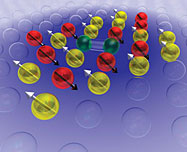- Number 287 |
- May 25, 2009
Decades after superconducting 'Woodstock,' supercomputers delve into HTSC mysteries

Simulations of embedded atom
clusters revealed that spin
fluctuations cause electrons to
form a superconducting state
in the Hubbard model of cuprate
superconductors.
While physicists rarely have the image of the 1960s counterculture, the first American Physical Society session on high-temperature superconductors, held in 1987 at New York City's Hilton Hotel, has been termed by some the "Woodstock of Physics." Excited by the discovery of high-temperature superconductors (HTSCs) the previous year, more than 2,000 physicists packed a hotel meeting room and spilled out into the corridors, fighting for the privilege of hearing the technical papers first-hand. The session lasted all night. The conference is perhaps the only meeting of physicists ever characterized as "a riot."
Twenty years after "Woodstock," the potential of high temperature superconductors both tantalizes and taunts the scientific community. Not unlike Woodstock, the jubilation of 1987 eventually encountered reality. Fulfilling the promise has proved to be much harder than predicted by many of those starry-eyed physicists two decades ago. HTSCs are being used in some applications, and the technology is advancing, but superconductivity is far from being a part of daily life.
The technological breakthroughs needed to accelerate the pace of superconductivity research may now be possible with a new generation of supercomputers. In calculations conducted during 2006, a team of scientists used the unparalleled computing resources at Oak Ridge National Laboratory to identify a mechanism that provides clues to the mystery of how HTSC materials work. The discovery may eventually help to realize the potential of these highly energy-efficient materials.
Scientists know that some force causes electrons to form Cooper pairs via a pairing interaction. The 2006 simulations, also run on Phoenix, were aimed at identifying the force. They revealed that the interaction behind Cooper pairing is driven by a mechanism called "spin fluctuation," a magnetic effect associated with the rotation of electrons.
A theoretical understanding of why HTSCs lose their resistance to electricity remains elusive. "There has been a huge amount of theoretical and experimental work on high-temperature superconducting systems, but no complete understanding," says ORNL's Thomas Maier. "One especially would like to understand what causes the pairing interaction and why these systems become superconducting."
Submitted by DOE's Oak Ridge National Laboratory
